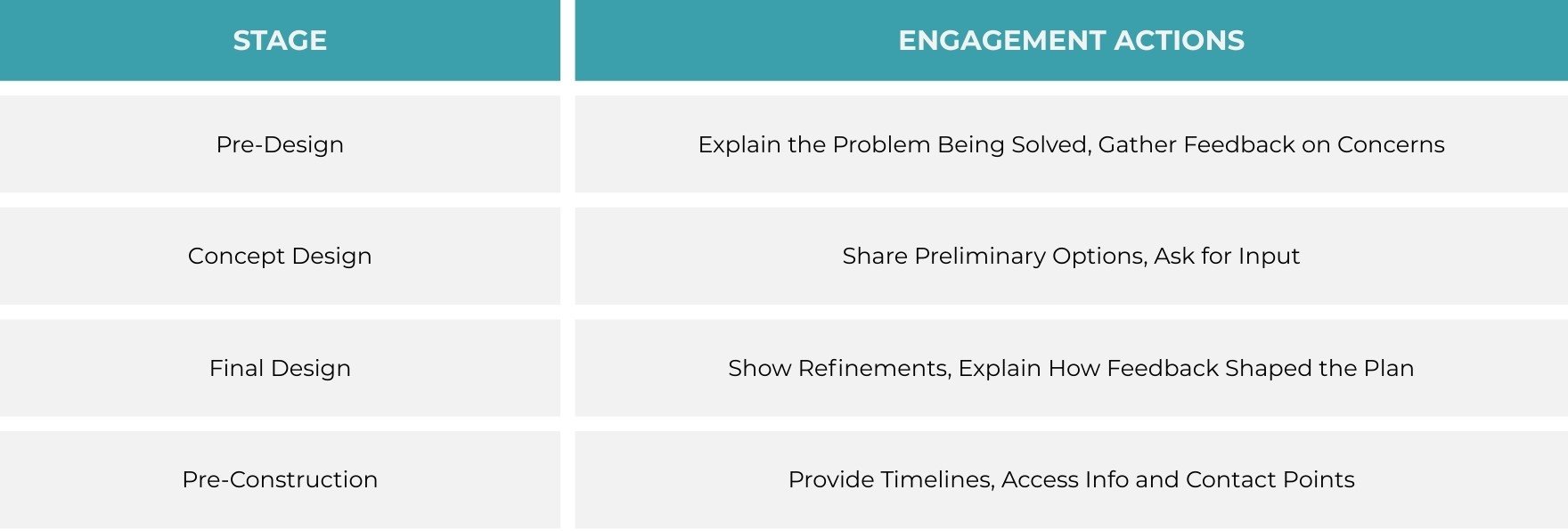How Early Engagement Can Prevent Public Backlash
Every infrastructure project affects people.
Whether you’re building a water treatment plant, a new road, or a recreation facility, there are always questions:
Who decided this was needed?
What’s it going to cost?
How will it affect my home, my commute, or my business?
If you wait until shovels are in the ground to answer those questions, it’s often too late.
That’s where early engagement comes in. It helps reduce risk, avoid delays, and build trust, long before the first piece of equipment shows up on site.
What Is Early Engagement?
Early engagement means talking to people before final decisions are made. It involves reaching out to those who will be affected by a project: residents, Indigenous communities, local businesses, elected officials, advocacy groups, and more.
You listen, explain, gather input, and build relationships.
It’s not just a public open house. It’s not just a mailout. And it’s not a checkbox after the design is done.
True early engagement starts when options are still being considered, not after everything is finalized.
Why Does Early Engagement Matter?
1. Prevents Misinformation
If you don’t tell your story, someone else will.
Waiting too long to communicate opens the door to rumours and misunderstandings. People fill in the blanks with assumptions and those assumptions often turn negative.
Early engagement helps shape the story before it spreads.
2. Reduces Opposition
People don’t like surprises. When they’re left out of the process, they get frustrated. That frustration turns into backlash, sometimes loud, organized, and political.
If you allow people to ask questions early, many concerns can be addressed before they become conflicts.
3. Builds Trust
Engaging early shows respect. It tells people:
“We want to get this right. And we want to hear from you first.”
That kind of trust is hard to build late and easy to lose.
4. Improves Project Design
Community members often know things that engineers and planners don’t. They might flag issues like access, traffic patterns, cultural concerns, or seasonal flooding, before you commit to a flawed design.
Early engagement can prevent costly rework later on.
Real-World Example: Wastewater Treatment Facility Upgrade
A mid-sized municipality was planning a wastewater treatment upgrade near a residential area. Originally, the plan was to start public communications once construction was underway.
However, based on past project delays, the city began outreach early.
A team hosted community sessions, explained why the upgrade was needed, addressed odour control concerns, and showed how the site would be landscaped.
Residents voiced concerns about traffic and nighttime noise. As a result, the project team adjusted haul routes and limited overnight work.
Because people were involved early, they felt heard. No major complaints were filed, and the project stayed on track.
What Happens Without Early Engagement?
Case: Multi-use Facility with Last-Minute Notice
A new multi-use facility was approved and designed with little public engagement. Residents first heard about it through a construction notice delivered two weeks before site work began.
What followed:
Letters to councillors
Angry calls to the city
Local media coverage
A protest at the construction site
A stop-work order pending review
The issue wasn’t the project; it was how people were informed.
In the end, months were lost, and costs went up. The backlash could have been avoided with early outreach.
When Should You Start Engaging?
The earlier, the better, especially for large or sensitive projects.
Key milestones to begin engagement:
Engaging early doesn’t mean rushing public meetings. It means bringing the public into the process from the start.
What Should Early Engagement Include?
A basic plan should answer:
Who will be affected?
What do they care about?
What risks could trigger public opposition?
How will people give input?
What tools will be used (mailers, meetings, web updates, etc.)?
Who is responsible for responses and follow-up?
Early engagement doesn’t need to be expensive, but it does need to be organized.
Who Should Lead It?
Engineers, architects, and project managers often focus on technical success. However, communications requires a different skill set.
That’s why many successful projects bring in a communications firm like reVerb early in the process.
We help:
Write and deliver plain-language project overviews
Plan stakeholder outreach that fits the project scale and location
Facilitate early community or stakeholder meetings
Track input and prepare summary reports
Train your project team to respond clearly and consistently
Build trust with local groups and Indigenous communities
When you engage early, the conversation is easier. The tone is better. And the outcome is smoother.
Don’t Wait for Problems to Communicate
When complaints hit your inbox or media calls start coming in, the damage is done.
Early engagement is about prevention, not reaction.
It makes the public part of the process, instead of an obstacle.
Final Thoughts
Projects fail when people feel left out. They succeed when people feel involved, informed, and respected.
Early engagement isn’t just good practice; it’s risk management. It reduces costs, builds support, and helps teams focus on building, not battling backlash.
If you’re planning a construction or infrastructure project and need early engagement that works, reVerb Communications is here to help.


